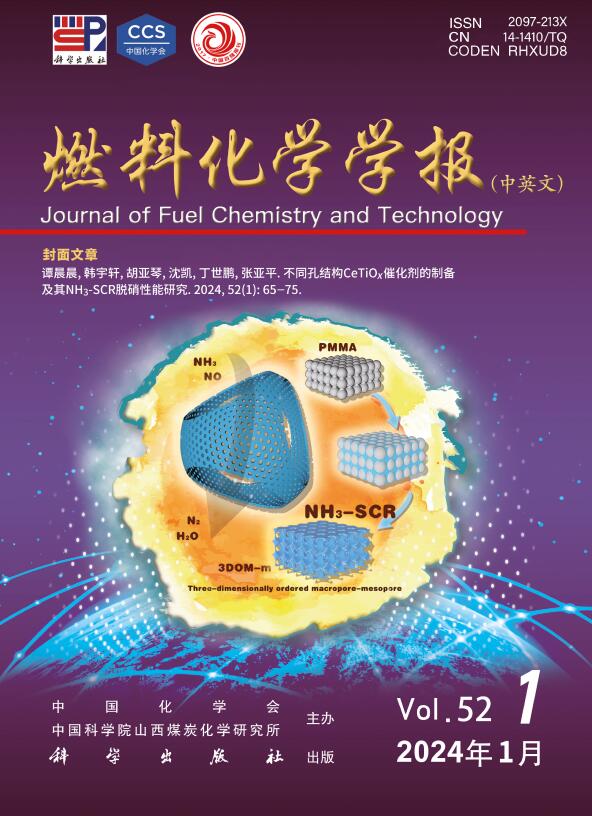Tar formation characteristic of integrated process of coal pyrolysis with dry reforming of low carbon alkane over Ni/La2O3-ZrO2
Q3 Energy
引用次数: 0
Abstract
Coal pyrolysis integrated with dry reforming of low-carbon alkane (CP-DRA) is an effective way to improve tar yield. Ni/La2O3-ZrO2 with a La/Zr ratio of 4 was a good catalyst for DRA to inhibit carbon deposition and obtain high tar yield in CP-DRA. In this study, the fraction distribution and component of tars from CP-DRA and coal pyrolysis in N2 atmosphere (CP-N2) were characterized by using several methods to understand the effect of DRA on coal pyrolysis. The isotope trace method was also used to discuss the role of low-carbon alkane in CP-DRA. The results showed that the tar from CP-N2 is mainly composed of aliphatic compounds with more Cal, Hal and CH+CH2, and the tar from CP-DRA contains more Car, Har, and CH3, and has lower weight-average molecular weight and more light tar content than CP-N2. A small amount of C2H6 addition in CP-DRA will raise the ratio of Hβ and CH+CH2. Electron paramagnetic resonance (EPR) analysis shows that the tar from CP-DRA has a higher radical concentration while the corresponding char has a lower radical concentration. The isotope trace experiment showed that alkanes provide ·H, ·CH3, etc. to stabilize the radicals from coal pyrolysis and result in more alkyl aromatic compounds during CP-DRA.
Ni/La2O3-ZrO2上煤热解-低碳烷烃干重整一体化过程焦油形成特征
煤热解结合低碳烷烃干重整是提高焦油收率的有效途径。La/Zr比为4的Ni/La2O3-ZrO2是抑制CP-DRA积碳和获得高焦油收率的良好催化剂。本研究通过多种方法表征了CP-DRA和煤在N2气氛(CP-N2)下热解产生的焦油的馏分分布和组分,以了解DRA对煤热解的影响。用同位素示踪法探讨了低碳烷烃在CP-DRA中的作用。结果表明,CP-N2制得的焦油主要由含有较多Cal、Hal和CH+CH2的脂肪族化合物组成,CP-DRA制得的焦油含有较多Car、Har和CH3,比CP-N2制得的焦油平均分子量更低,焦油含量更轻。在CP-DRA中加入少量的C2H6会提高Hβ和CH+CH2的比值。电子顺磁共振(EPR)分析表明,CP-DRA的焦油具有较高的自由基浓度,而相应的焦炭具有较低的自由基浓度。同位素示踪实验表明,烷烃提供了·H、·CH3等,稳定了煤热解过程中的自由基,生成了更多的烷基芳香族化合物。
本文章由计算机程序翻译,如有差异,请以英文原文为准。
求助全文
约1分钟内获得全文
求助全文
来源期刊

燃料化学学报
Chemical Engineering-Chemical Engineering (all)
CiteScore
2.80
自引率
0.00%
发文量
5825
期刊介绍:
Journal of Fuel Chemistry and Technology (Ranliao Huaxue Xuebao) is a Chinese Academy of Sciences(CAS) journal started in 1956, sponsored by the Chinese Chemical Society and the Institute of Coal Chemistry, Chinese Academy of Sciences(CAS). The journal is published bimonthly by Science Press in China and widely distributed in about 20 countries. Journal of Fuel Chemistry and Technology publishes reports of both basic and applied research in the chemistry and chemical engineering of many energy sources, including that involved in the nature, processing and utilization of coal, petroleum, oil shale, natural gas, biomass and synfuels, as well as related subjects of increasing interest such as C1 chemistry, pollutions control and new catalytic materials. Types of publications include original research articles, short communications, research notes and reviews. Both domestic and international contributors are welcome. Manuscripts written in Chinese or English will be accepted. Additional English titles, abstracts and key words should be included in Chinese manuscripts. All manuscripts are subject to critical review by the editorial committee, which is composed of about 10 foreign and 50 Chinese experts in fuel science. Journal of Fuel Chemistry and Technology has been a source of primary research work in fuel chemistry as a Chinese core scientific periodical.
 求助内容:
求助内容: 应助结果提醒方式:
应助结果提醒方式:


